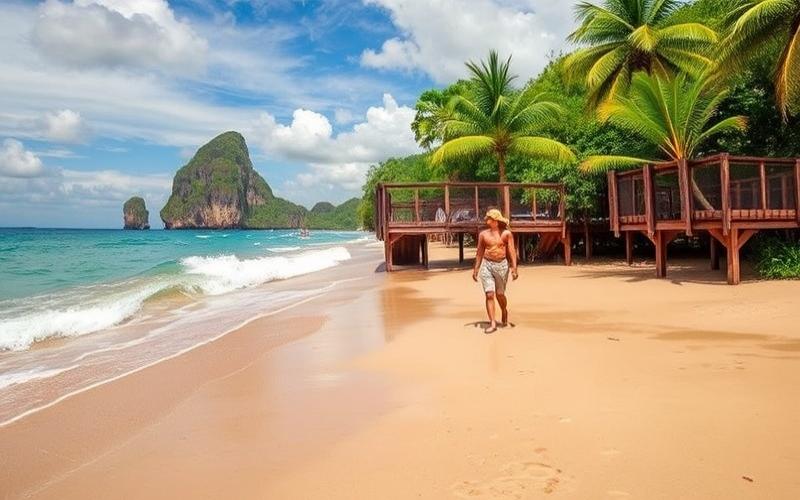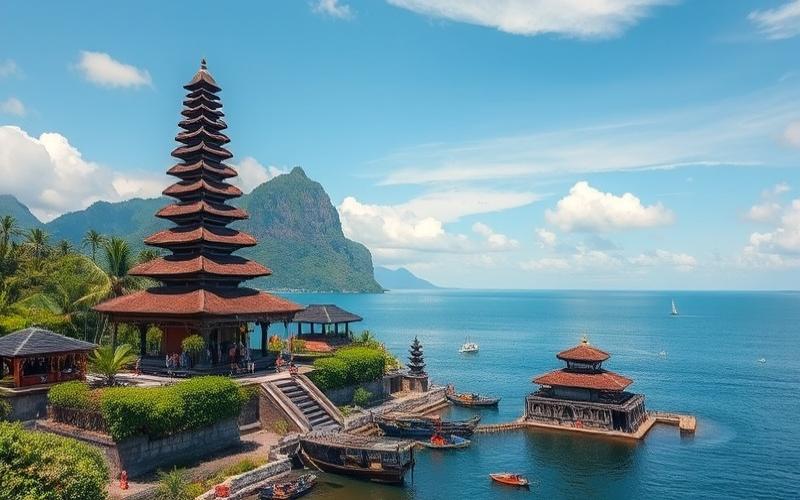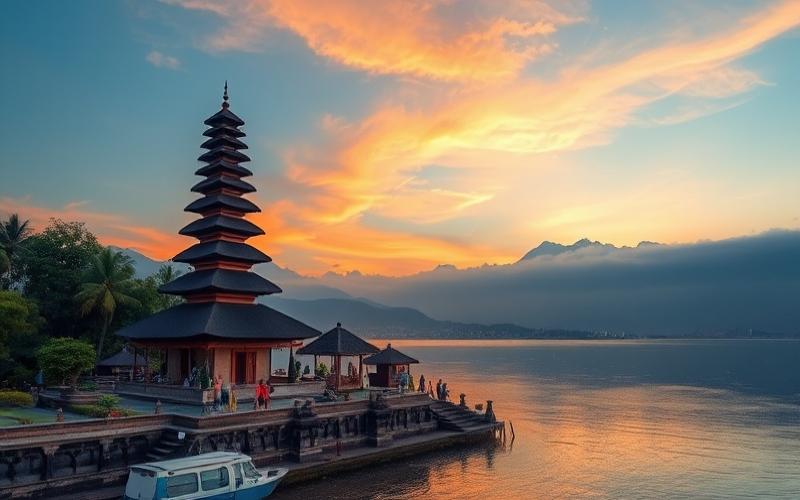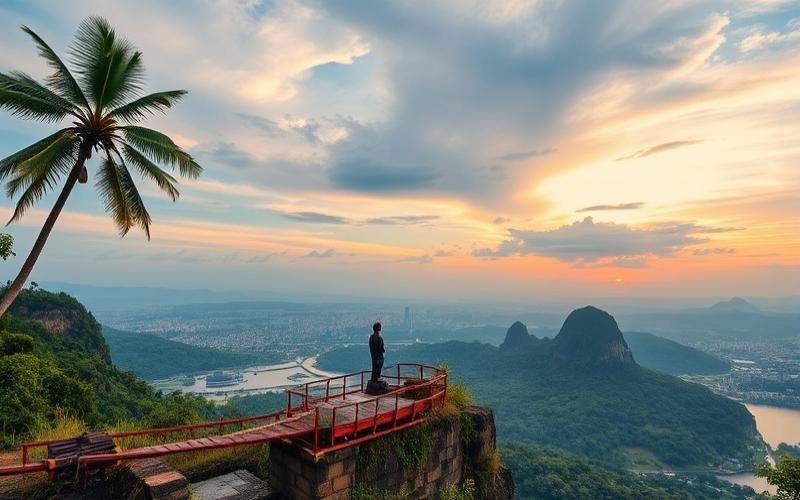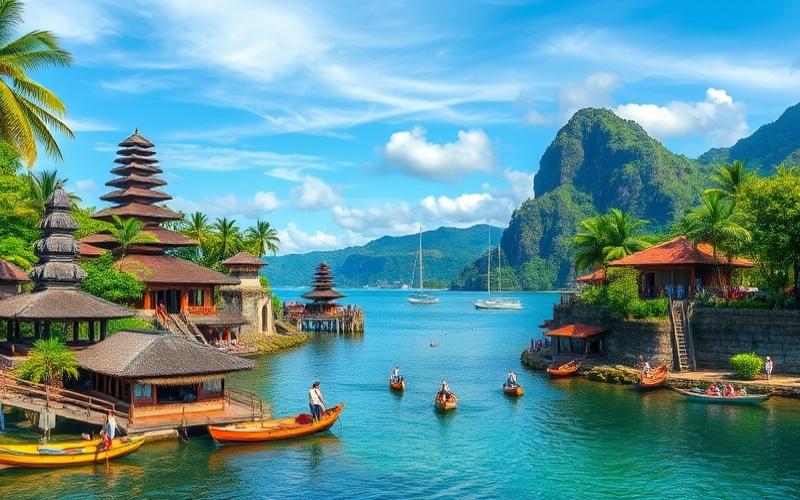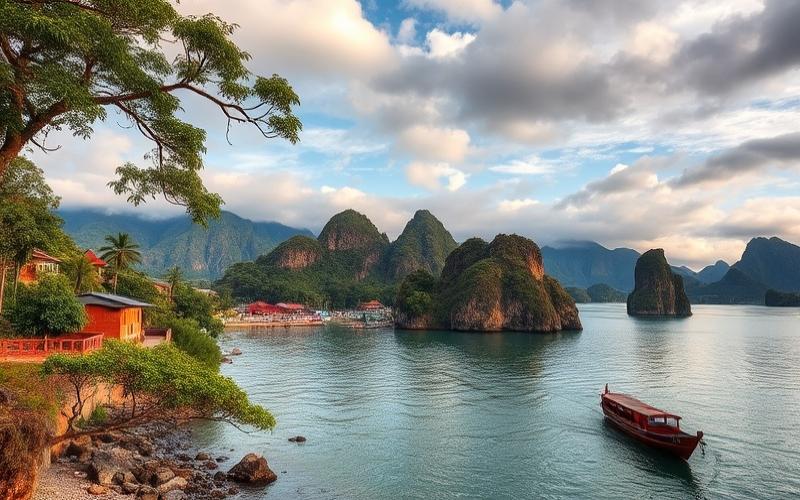
 Published on and written by Cyril Jarnias
Published on and written by Cyril Jarnias
Indonesia, with its breathtaking landscapes and cultural richness, is a country where exploring daily life reveals many surprises. For those wishing to discover the complexity of its vibrant cities and paradise islands, public transportation represents a practical and authentic solution.
From Jakarta’s packed buses to traditional boats connecting islands, each mode of transport offers a new adventure. Understanding how to navigate these multiple networks while adopting local customs might seem intimidating at first.
However, this practical guide is designed to provide you with the essential keys to transform every journey into an enriching and stress-free experience. Embark on a trip where urban and natural landscapes unfold, guided by tips that will facilitate your daily travels across this fascinating archipelago.
Exploring Different Indonesian Transportation Modes
Local Buses (bus kota, Transjakarta, Trans Metro, DAMRI, etc.)
Buses are the backbone of urban transportation in Indonesia, with organized networks (Transjakarta in Jakarta, Trans Metro in Bandung, Trans Semarang, Trans Jogja, etc.) and classic local routes.
In Jakarta, Transjakarta offers a bus rapid transit (BRT) system with dedicated lanes, air conditioning, and high frequency (every 2 to 5 minutes during peak hours).
In Bandung, the Trans Metro network operates with modern articulated buses and frequencies of 5 to 15 minutes depending on the route.
Classic local buses, often less comfortable, serve outlying neighborhoods with more variable frequencies (10 to 30 minutes).
Typical fares: 3,500 to 5,000 IDR for urban buses (Transjakarta), up to 10,000 IDR for intercity trips.
Access: Purchase electronic cards (Jakarta: e-money card or JakLingko) or pay cash on classic buses.
Trains
The railway network mainly serves Java and Sumatra, with intercity connections (Jakarta–Bandung, Jakarta–Surabaya, etc.) and commuter trains (KRL Jabodetabek in Jakarta).
In Jakarta, the KRL connects suburbs to the city with a frequency of 10 to 15 minutes.
Bandung has a light rail train (LRT) under development.
Fares: 3,000 to 10,000 IDR for commuter trains, depending on distance; intercity trains from 50,000 to 500,000 IDR depending on class.
Access: Ticket machines, online purchase, or on-site.
Bajaj
Three-wheeled motor vehicle, typical of Jakarta and other major cities.
Used for short distances, often negotiated per trip (no meter).
Authentic experience but noisy and uncomfortable.
Fare: 10,000 to 30,000 IDR depending on distance and negotiation.
Bemo
Minibus or small converted van, especially in medium-sized cities or outlying areas.
Operates on fixed routes, flexible boarding/alighting.
Fare: 3,000 to 7,000 IDR per trip.
Angkot
Local minibus, ubiquitous in cities of Java, Sumatra, and Sulawesi.
No fixed schedules, departure when vehicle is full.
Routes identified by color or number.
Fare: 3,000 to 7,000 IDR, direct payment to driver.
Inter-island Ferries
Essential for travel between major islands (Java, Sumatra, Bali, Lombok, Sulawesi).
Mainly operated by the public company ASDP.
Frequent crossings on major routes (Java-Bali, Java-Sumatra), sometimes every 30 minutes.
Fares: 7,000 to 50,000 IDR for a pedestrian depending on the crossing.
Access: Ticket purchase at port or online.
| Mode | Typical Frequency | Fare (IDR) | User Experience | Access |
|---|---|---|---|---|
| Urban Bus | 2-15 min | 3,500 – 10,000 | Variable (modern on BRT, basic elsewhere) | Card or cash |
| Train | 10-30 min | 3,000 – 500,000 | Comfortable, air-conditioned, punctual | Ticket machine, e-ticket |
| Bajaj | On demand | 10,000 – 30,000 | Typical, noisy, negotiation required | Stop or street, negotiation |
| Bemo | Variable | 3,000 – 7,000 | Simple, local, uncomfortable | Flexible boarding |
| Angkot | Variable | 3,000 – 7,000 | Crowded, flexible stops, no schedules | Hop on/off |
| Ferry | 30 min – 2 h | 7,000 – 50,000 | Functional, sometimes crowded | Port, ticket on-site/online |
Practical Tips and Anecdotes
- Punctuality: BRT buses and urban trains are relatively punctual, but classic buses, angkot, and bemo can be unpredictable.
- Safety: Watch for pickpockets in crowded transport; keep valuables close.
- Air Conditioning: BRT buses and trains are air-conditioned, unlike most angkot, bemo, or bajaj.
- Language: Angkot, bemo, or bajaj drivers rarely speak English; prepare your route in advance or show it on a map.
- Mobile App: Use Google Maps or local apps to check routes and schedules (Transjakarta, KRL).
- Experience: Riding a crowded angkot in Bandung or negotiating a bajaj ride in Jakarta is part of the local folklore.
- Payment: Always carry small change for traditional transport.
Good to Know:
For inter-island trips, book ferries in advance during holidays or long weekends, as demand surges and waiting lines can be very long.
Good to Know:
Schedules can vary significantly depending on weather, traffic jams, or holidays. Always allow extra time if you have a connection or flight to catch.
Good to Know:
Angkots are often crowded and slow in Jakarta but offer an authentic glimpse of local life; consider using mobile apps to track bus schedules and avoid peak hours on trains. The ferry is the most economical way to travel between islands, but schedules can be unpredictable.
What Budget Should Expats Plan For?
| Transport Type | Average Fare per Trip | Monthly Subscription | Urban Area Availability | Rural Area Availability |
|---|---|---|---|---|
| Urban Buses (TransJakarta, Trans Sarbagita, etc.) | 3,500 to 15,000 IDR ($0.20 to $0.90) | ≈ 150,000 IDR ($7.80) | Highly developed in Jakarta, Bali, major cities | Rare, often replaced by minibus or angkot |
| Commuter Train | 5,000 to 15,000 IDR ($0.30 to $0.90) | ≈ 150,000 IDR ($7.80) | Available in Jakarta and major metros | Non-existent |
| MRT (Jakarta Metro) | 5,000 to 15,000 IDR ($0.30 to $0.90) | ≈ 150,000 IDR ($7.80) | Only in Jakarta | Non-existent |
| Minibus (angkot) | 3,000 to 7,000 IDR ($0.20 to $0.50) | No subscription | Everywhere, especially outside city centers | Main mode in rural areas |
| Online Services (Gojek, Grab) | 10,000 to 50,000 IDR ($0.60 to $3) depending on distance | No subscription | Available in all major cities | Limited coverage in countryside |
| Taxi | Flag drop: 10,000 IDR ($0.52) + 6,000 IDR/km ($0.31/km) | No subscription | Available in all cities | Infrequent in rural areas |
Additional Cost and Subscription Information
Single tickets for public transport cost on average 5,000 IDR ($0.26), monthly subscriptions around 150,000 IDR ($7.80).
Subscriptions generally cover unlimited trips within the urban network (bus, metro, commuter train).
Local buses and angkot do not offer subscriptions, payment in cash or via prepaid transport card.
Online transport services (Gojek, Grab) are paid per trip; variable fares depending on time, distance, and demand.
Price Differences Between Urban and Rural Areas
In urban areas (Jakarta, Bali, Surabaya), modern transport (rapid buses, MRT, trains) is accessible, cheap, and offers subscriptions.
In rural areas, options are limited to minibuses or local taxis, often less comfortable and without packages, but prices remain very low.
Efficient Payment Methods for Expats
- Prepaid transport cards (Jakarta: JakLingko, Bali: e-money, Flazz, etc.): rechargeable at stations or convenience stores, practical to avoid change.
- Mobile payment: Gojek and Grab apps integrate contactless payment via e-wallet (GoPay, OVO).
- Cash: still widely used for angkot, rural buses, and some taxis.
Discount Programs and Benefits for Expats
No specific discounts for foreign residents on public networks.
Some loyalty programs or credits offered on Gojek/Grab apps upon registration or through occasional promotions.
Children, students, and seniors sometimes benefit from reduced fares, mainly for local residents.
Seasonal Cost Variations
Public transport fares (bus, metro, train) remain stable year-round, even during tourist seasons or holidays.
Prices for online transport services (Gojek, Grab) and taxis can increase significantly during tourist peaks, national holidays (Lebaran, New Year, etc.), or during high demand (rain, traffic jams).
Practical Tips for Expats
- Prefer prepaid transport cards for daily trips, especially in Jakarta.
- Use Gojek or Grab for more flexibility, especially outside peak hours.
- Check promotions or special offers in mobile apps.
- For long stays, subscribe to a monthly plan in major cities to reduce costs.
Good to Know:
In Indonesia, expats can use various means of transport such as buses, trains, metro (in Jakarta), and online transport apps, with costs ranging around $0.20 to $1.50 per trip depending on the area; prepaid transport cards like e-money or Flazz are recommended to benefit from discounts and avoid fare increases during tourist seasons.
Practical Tips for Using Public Transportation in Indonesia
Practical Tips for Planning Your Route with Public Transportation in Indonesia:
- Use local mobile apps like Gojek, Grab, Traveloka, or Moovit to check routes, buy tickets, track real-time schedules, and potential disruptions.
- Verify service schedules before each trip, especially for intercity travel and early morning or late evening journeys, as frequency may vary by region and holidays.
- Allow enough time for each trip, considering potentially heavy traffic, particularly in major cities like Jakarta, Surabaya, or Bali.
- Prefer official services: municipal buses (TransJakarta, Teman Bus in Bali), trains (KRL, MRT Jakarta), and recognized companies for intercity connections.
Table of Main Apps and Suitable Payment Methods:
| Application / Service | Main Features | Recommended Payment Method |
|---|---|---|
| Gojek / Grab | Navigation, ride-hailing, bus, integrated payment, ticket purchase | E-wallet (GoPay, OVO), bank card, cash |
| Traveloka | Train, bus, flight ticket purchase | Bank card, e-wallet |
| Moovit | Routes, real-time schedules | Not applicable (consultation only) |
| Teman Bus | Public bus tickets in Bali | Cash, QRIS (mobile payment) |
| KAI Access (train) | Train ticket reservation | Bank card, e-wallet, QRIS |
Tips for Personal Safety:
- Always keep personal belongings under watch: bag in front, valuables concealed.
- Avoid wearing flashy items or carrying large amounts of cash.
- Prefer well-lit and busy stops and stations, especially in the evening.
- Use only official services and avoid unmarked taxis or buses.
Cultural Aspects to Respect:
- Show respect in queues, letting elderly, pregnant women, and people with children or disabilities go first.
- Greet and thank staff and fellow passengers; a smile is always appreciated.
- Avoid speaking loudly or occupying multiple seats with belongings.
- Accept potential crowding in transport and remain courteous during interactions.
Payment Method Recommendations:
- Local e-wallets (GoPay, OVO, Dana) are widespread and allow quick payment in buses, trains, ride-hailing, and official kiosks.
- QRIS: universal mobile payment system via QR code accepted in most public transport.
- Cash always useful, especially in rural areas or for small urban trips where digitalization is less advanced.
- Bank cards accepted for online bookings and in some main stations or terminals.
List of Best Practices for a Successful Trip:
- Download and set up main transport apps before departure.
- Top up e-wallet or prepare local currency for payments.
- Learn about regional specifics and rules for each transport mode.
- Respect signage and operator instructions.
- Be flexible and patient with unexpected traffic or weather conditions.
Important text: Allowing extra time for each trip is essential in Indonesia, due to traffic density and public transport network uncertainties, especially in large urban areas and during peak periods.
Good to Know:
Use mobile apps like GO-JEK or Grab to plan your trips and buy tickets, while considering schedules and avoiding peak hours due to heavy traffic. Plan payments with prepaid cards like JakCard for ease, and watch your personal belongings while respecting local rules, such as queuing and courteous interactions with other passengers.
Disclaimer: The information provided on this website is for informational purposes only and does not constitute financial, legal, or professional advice. We encourage you to consult qualified experts before making any investment, real estate, or expatriation decisions. Although we strive to maintain up-to-date and accurate information, we do not guarantee the completeness, accuracy, or timeliness of the proposed content. As investment and expatriation involve risks, we disclaim any liability for potential losses or damages arising from the use of this site. Your use of this site confirms your acceptance of these terms and your understanding of the associated risks.






